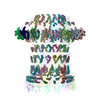[English] 日本語
 Yorodumi
Yorodumi- PDB-6hcg: Klebsiella pneumoniae type II secretion system outer membrane com... -
+ Open data
Open data
- Basic information
Basic information
| Entry | Database: PDB / ID: 6hcg | ||||||
|---|---|---|---|---|---|---|---|
| Title | Klebsiella pneumoniae type II secretion system outer membrane complex. PulD, PulS and PulC HR domain. | ||||||
 Components Components |
| ||||||
 Keywords Keywords | PROTEIN TRANSPORT / Type II secretion system / secretin / outer membrane channel | ||||||
| Function / homology |  Function and homology information Function and homology informationprotein secretion by the type II secretion system / type II protein secretion system complex / intracellular protein transport / cell outer membrane / identical protein binding / plasma membrane Similarity search - Function | ||||||
| Biological species |  Klebsiella pneumoniae (bacteria) Klebsiella pneumoniae (bacteria) | ||||||
| Method | ELECTRON MICROSCOPY / single particle reconstruction / cryo EM / Resolution: 4.3 Å | ||||||
 Authors Authors | Chernyatina, A.A. / Low, H.H. | ||||||
| Funding support |  United Kingdom, 1items United Kingdom, 1items
| ||||||
 Citation Citation |  Journal: Nat Commun / Year: 2019 Journal: Nat Commun / Year: 2019Title: Core architecture of a bacterial type II secretion system. Authors: Anastasia A Chernyatina / Harry H Low /  Abstract: Bacterial type II secretion systems (T2SSs) translocate virulence factors, toxins and enzymes across the cell outer membrane. Here we use negative stain and cryo-electron microscopy to reveal the ...Bacterial type II secretion systems (T2SSs) translocate virulence factors, toxins and enzymes across the cell outer membrane. Here we use negative stain and cryo-electron microscopy to reveal the core architecture of an assembled T2SS from the pathogen Klebsiella pneumoniae. We show that 7 proteins form a ~2.4 MDa complex that spans the cell envelope. The outer membrane complex includes the secretin PulD, with all domains modelled, and the pilotin PulS. The inner membrane assembly platform components PulC, PulE, PulL, PulM and PulN have a relative stoichiometric ratio of 2:1:1:1:1. The PulE ATPase, PulL and PulM combine to form a flexible hexameric hub. Symmetry mismatch between the outer membrane complex and assembly platform is overcome by PulC linkers spanning the periplasm, with PulC HR domains binding independently at the secretin base. Our results show that the T2SS has a highly dynamic modular architecture, with implication for pseudo-pilus assembly and substrate loading. | ||||||
| History |
|
- Structure visualization
Structure visualization
| Movie |
 Movie viewer Movie viewer |
|---|---|
| Structure viewer | Molecule:  Molmil Molmil Jmol/JSmol Jmol/JSmol |
- Downloads & links
Downloads & links
- Download
Download
| PDBx/mmCIF format |  6hcg.cif.gz 6hcg.cif.gz | 1.8 MB | Display |  PDBx/mmCIF format PDBx/mmCIF format |
|---|---|---|---|---|
| PDB format |  pdb6hcg.ent.gz pdb6hcg.ent.gz | 1.5 MB | Display |  PDB format PDB format |
| PDBx/mmJSON format |  6hcg.json.gz 6hcg.json.gz | Tree view |  PDBx/mmJSON format PDBx/mmJSON format | |
| Others |  Other downloads Other downloads |
-Validation report
| Arichive directory |  https://data.pdbj.org/pub/pdb/validation_reports/hc/6hcg https://data.pdbj.org/pub/pdb/validation_reports/hc/6hcg ftp://data.pdbj.org/pub/pdb/validation_reports/hc/6hcg ftp://data.pdbj.org/pub/pdb/validation_reports/hc/6hcg | HTTPS FTP |
|---|
-Related structure data
| Related structure data |  0193MC M: map data used to model this data C: citing same article ( |
|---|---|
| Similar structure data |
- Links
Links
- Assembly
Assembly
| Deposited unit | 
|
|---|---|
| 1 |
|
- Components
Components
| #1: Protein | Mass: 70328.633 Da / Num. of mol.: 15 Source method: isolated from a genetically manipulated source Source: (gene. exp.)  Klebsiella pneumoniae (bacteria) Klebsiella pneumoniae (bacteria)Gene: gspD, pulD, B4U30_01620, BANRA_04386, BL124_00006830, C3F39_10150, CK508_015045, E0760_18600, E1814_01470, EAO17_18605, SK89_02022 Production host:  #2: Protein | Mass: 15872.848 Da / Num. of mol.: 15 Source method: isolated from a genetically manipulated source Source: (gene. exp.)  Klebsiella pneumoniae (bacteria) / Gene: BU230_24515 / Production host: Klebsiella pneumoniae (bacteria) / Gene: BU230_24515 / Production host:  #3: Protein | Mass: 30245.924 Da / Num. of mol.: 15 Source method: isolated from a genetically manipulated source Source: (gene. exp.)  Klebsiella pneumoniae (bacteria) Klebsiella pneumoniae (bacteria)Gene: pulC, gspC, outC, B1727_29100, B4U22_01185, BL124_0006760, C3F39_10145, C9J88_23460, CPT10_02240, CSC88_13925, CWQ24_23120, KpST82_0728, PMK1_02469, SM57_00150 Production host:  Has protein modification | Y | |
|---|
-Experimental details
-Experiment
| Experiment | Method: ELECTRON MICROSCOPY |
|---|---|
| EM experiment | Aggregation state: PARTICLE / 3D reconstruction method: single particle reconstruction |
- Sample preparation
Sample preparation
| Component | Name: Klebsiella pneumoniae type II secretion system outer membrane complex. PulD, PulS and PulC HR domain. Type: COMPLEX / Entity ID: all / Source: RECOMBINANT |
|---|---|
| Molecular weight | Value: 1.3 MDa / Experimental value: NO |
| Source (natural) | Organism:  Klebsiella pneumoniae (bacteria) Klebsiella pneumoniae (bacteria) |
| Source (recombinant) | Organism:  |
| Buffer solution | pH: 7.5 |
| Specimen | Embedding applied: NO / Shadowing applied: NO / Staining applied: NO / Vitrification applied: YES |
| Vitrification | Cryogen name: ETHANE |
- Electron microscopy imaging
Electron microscopy imaging
| Experimental equipment |  Model: Titan Krios / Image courtesy: FEI Company |
|---|---|
| Microscopy | Model: FEI TITAN KRIOS |
| Electron gun | Electron source:  FIELD EMISSION GUN / Accelerating voltage: 300 kV / Illumination mode: FLOOD BEAM FIELD EMISSION GUN / Accelerating voltage: 300 kV / Illumination mode: FLOOD BEAM |
| Electron lens | Mode: BRIGHT FIELD |
| Image recording | Average exposure time: 0.3 sec. / Electron dose: 1.25 e/Å2 / Film or detector model: GATAN K2 SUMMIT (4k x 4k) |
- Processing
Processing
| EM software |
| ||||||||||||
|---|---|---|---|---|---|---|---|---|---|---|---|---|---|
| CTF correction | Type: PHASE FLIPPING AND AMPLITUDE CORRECTION | ||||||||||||
| Symmetry | Point symmetry: C15 (15 fold cyclic) | ||||||||||||
| 3D reconstruction | Resolution: 4.3 Å / Resolution method: FSC 0.143 CUT-OFF / Num. of particles: 7284 / Symmetry type: POINT |
 Movie
Movie Controller
Controller







 PDBj
PDBj
